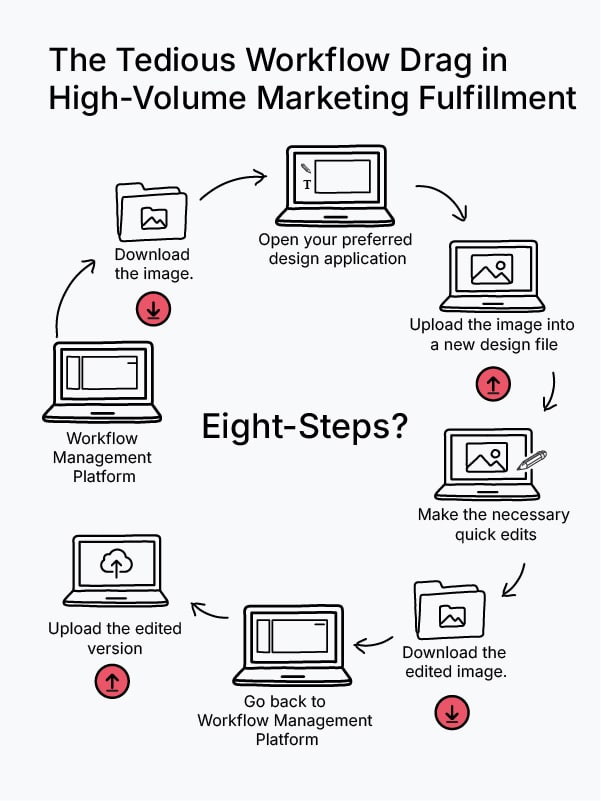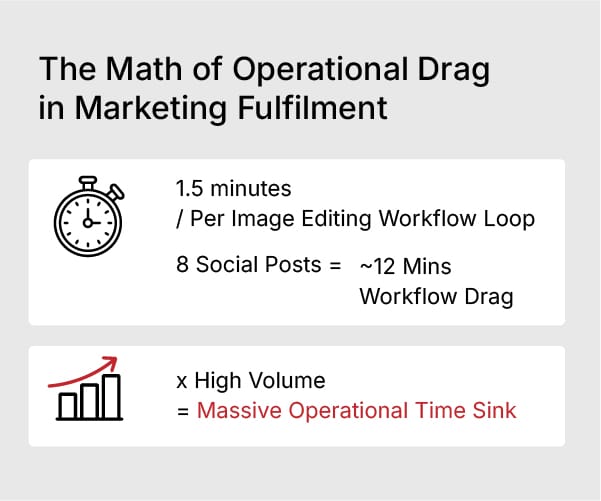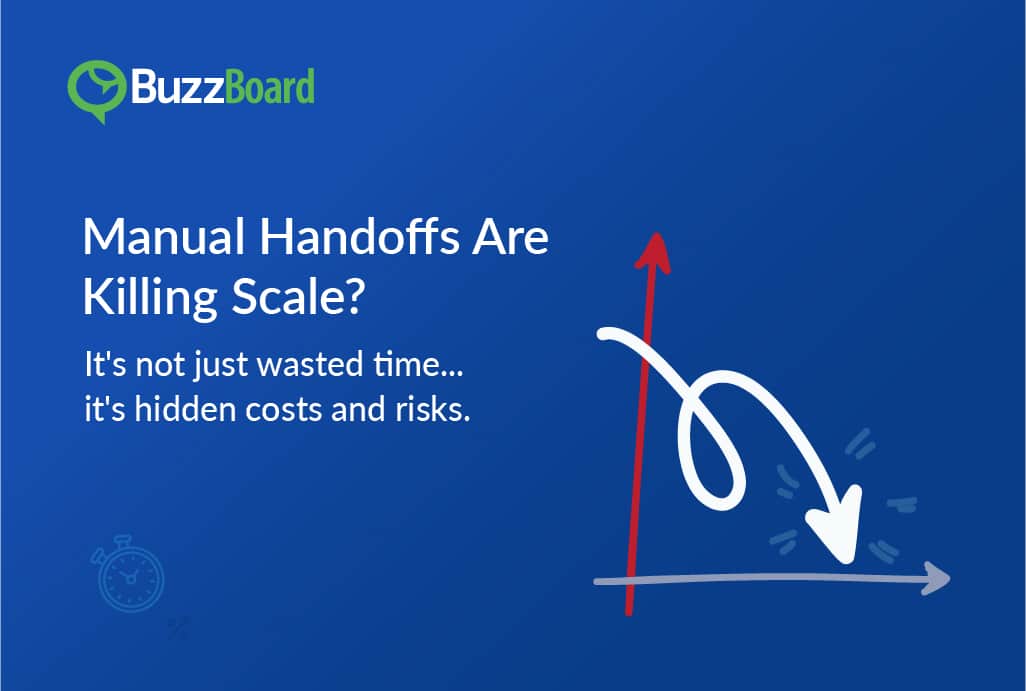Managing operations in a high-volume digital marketing setup – the kind built to serve hundreds or thousands of SMB clients efficiently – you know the pressure. Success isn’t just about smart strategy or great creatives; it’s about the machinery behind it. It’s the quiet hum of efficiency or the grating friction of bottlenecks that determines your profitability and limits your growth.
Often, friction comes from places you might not immediately flag as major strategic roadblocks. Small inefficiencies that, at scale, become huge, costly problems.
Here’s a classic example, one you’ve probably seen play out in your own creative or content fulfillment workflows.
The problem: The tedious two-step (or is it eight-step?)
Imagine part of your workflow requires taking a creative asset – say, an image generated for a social post – and doing a quick edit in a design tool. Maybe it needs cropping, resizing, or adding a logo. Simple stuff.
Here’s how that process often actually looks in many setups:
- Find the asset in your project/workflow platform (let’s call it Platform X).
- Download the image.
- Open your preferred design application (like Canva or Design Tool Y).
- Upload the image into a new design file.
- Make the necessary quick edits.
- Download the edited image.
- Go back to Platform X.
- Upload the final version to replace the original.

See that? That’s not a simple edit. That’s a digital hopscotch. A manual relay race just to get an asset from Point A (in the workflow) to Point B (back in the workflow, edited).
We actually measured this recently in a real scenario – that entire sequence? About 1.5 minutes per image.
1.5 minutes may not sound all that alarming. This is where the “volume” part of high-volume fulfillment kicks in!
Let’s do the math, the kind that matters in operations:
- 1.5 minutes per image.
- An average social post needs 1 image. Let’s say 8 posts per client update equals 12 minutes just in this download-edit-upload process.
- Now scale that. If you’re pushing, say, 30,000 social posts a month across your client base, and each one touches this process…
- That 1.5 minutes becomes a massive time sink across the operation. It’s not just one designer losing 12 minutes; it’s the aggregate loss of countless hours that could be spent on actual creative work or other high-value tasks.

That’s operational drag. That’s your process fighting against your team.
The real killer: Hidden costs and sleep-depriving errors
But the time cost, while significant at scale, isn’t the worst part. The real insidious cost of manual handoffs is the introduction of errors.
Every time a human manually downloads and uploads, there’s a chance for a mistake. Downloading the wrong file. Uploading the wrong version. Uploading an image meant for Client A into Client B’s project.
The kind of mistake that can lead to content for entirely different clients going live under the wrong brand name! An error like that isn’t just a “whoops”; it’s a potential crisis.
Here’s the operational reality of that risk:
- Firefighting is Your Norm: When an error does get through (and some always will), it triggers reactive chaos. Investigation, damage control, rework, client calls… all expensive, unpredictable, and soul-draining tasks that pull resources away from productive work.
- Auditing Becomes a Necessary Evil: Because you know these manual errors are possible (even if infrequent – say, a 1% error rate), you have to layer in costly, manual auditing steps downstream. You build walls specifically to catch mistakes that the process itself shouldn’t be creating. That’s a direct operational overhead, a tax you pay for inefficient workflows.
- Quality Suffers at Scale: Maintaining consistent quality becomes exponentially harder when the process itself is prone to unpredictable failures. You can throw more auditors at it, but you’re treating the symptom, not the disease.
Manual handoffs aren’t just inefficient; they are operational liabilities that introduce risk and create measurable, hidden costs in auditing and rework.
The solution: Seamless workflows powered by smart integration
The fix for this kind of workflow friction is straightforward in principle: eliminate the manual handoff.
Instead of making your team play digital hopscotch between platforms, bring the capabilities they need directly into their workflow.
Imagine this: The asset is in Platform X. You need to edit it. You click “Edit,” and Design Tool Y (or its capabilities) opens directly within Platform X. You make the edits in place. You click “Done.” The edited asset is automatically saved and updated in Platform X.
No download. No upload. No switching tabs unnecessarily.
That’s not just a nicer user experience (though it is that – ask your designers!). That’s process optimization. That’s removing the points of friction and the vectors for error.
The operational dividend: Time, trust, and throughput
The benefits for your operation are clear and quantifiable:
- Efficiency: You gain back those lost minutes per asset. Multiplied across your volume, that’s a significant boost in throughput capacity without adding headcount. Your cost per deliverable goes down.
- Effectiveness: You drastically reduce, or eliminate, the risk of errors introduced by the manual download/upload cycle. Your quality control improves inherently, allowing you to potentially reduce costly auditing steps. You ship content with greater confidence, mitigating risks to client relationships.
- Scalability: By removing manual bottlenecks, you make your operational pipeline more robust and capable of handling significantly higher volumes without breaking.
Beyond the bottleneck: Enabling the future of volume fulfillment
This creative workflow example is just one piece of the puzzle. High-volume digital marketing service fulfillment involves many steps – onboarding, data handling, personalization, content generation, scheduling, and reporting. Each step is a potential point of friction if it relies on manual handoffs between disconnected systems.
The reality is, you can’t build a truly scalable, efficient, and reliable high-volume operation for digital marketing service fulfillment on a foundation of clunky manual processes. They are the enemy of scale and the best friend of hidden costs and errors.
Furthermore, you aren’t effectively leveraging the power of AI for quality consistency, or hyper-personalization, or scaling if your fundamental workflows are broken. Addressing workflow friction isn’t just about fixing a single pain point; it’s about building the necessary operational infrastructure to support the future of digital marketing fulfillment.
Your call to operational excellence: Audit your handoffs
As an Ops or service delivery Manager, your job is to build the best possible machine. Take a critical look at your high-volume workflows. Recognize potential liabilities. Prioritize integrating your core tools and automating these manual handoffs.
It’s not just about making one task smoother; it’s about reducing operational costs, improving quality control, mitigating risk, and unlocking the true scalable potential of your digital marketing fulfillment engine.
Stop paying the tax of manual misery. Start building for scalable quality.

